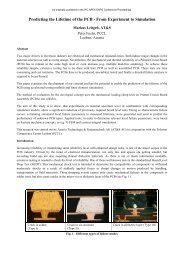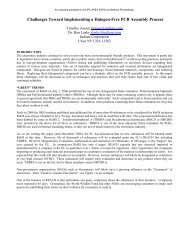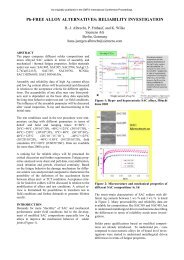PCB Design Perfection Starts in the Cad Library Part 1 ... - IPC Outlook
PCB Design Perfection Starts in the Cad Library Part 1 ... - IPC Outlook
PCB Design Perfection Starts in the Cad Library Part 1 ... - IPC Outlook
Create successful ePaper yourself
Turn your PDF publications into a flip-book with our unique Google optimized e-Paper software.
As orig<strong>in</strong>ally published <strong>in</strong> <strong>the</strong> <strong>IPC</strong> Pr<strong>in</strong>ted Circuit Expo, APEX & <strong>Design</strong>er Summit Proceed<strong>in</strong>gs.<br />
<strong>PCB</strong> <strong>Design</strong> <strong>Perfection</strong> <strong>Starts</strong> <strong>in</strong> <strong>the</strong> <strong>Cad</strong> <strong>Library</strong> <strong>Part</strong> 1 – The 1608 (Eia 0603) Chip<br />
Component<br />
Tom Hausherr<br />
EDA <strong>Library</strong> Product Manager<br />
Mentor Graphics Corp.<br />
tom_hausherr@mentor.com<br />
ABSTRACT<br />
The CAD library is <strong>the</strong> start<strong>in</strong>g po<strong>in</strong>t that affects every process from <strong>PCB</strong> layout through <strong>PCB</strong> manufactur<strong>in</strong>g and<br />
assembly. There are dozens of th<strong>in</strong>gs to consider when creat<strong>in</strong>g a CAD library that are often overlooked or not even<br />
considered that will directly affect <strong>the</strong> quality of <strong>the</strong> part placement, via fanout, trace rout<strong>in</strong>g, post process<strong>in</strong>g, fabrication<br />
and assembly processes. <strong>Part</strong> 1 of this paper describes every aspect that should be considered when creat<strong>in</strong>g chip CAD<br />
library parts and <strong>the</strong> impact that each feature of <strong>the</strong> CAD library has <strong>in</strong> <strong>the</strong> <strong>PCB</strong> process.<br />
INTRODUCTION:<br />
This paper is <strong>Part</strong> 1 of a series that is <strong>in</strong>tended as an <strong>in</strong>troduction to creat<strong>in</strong>g a high quality CAD library. We will review<br />
<strong>the</strong> elements of each component family on Tom Hausherr’s blog. We need to address questions like:<br />
� Why do we snap <strong>the</strong> lands (pads) to a 0.1mm grid?<br />
� Why is <strong>the</strong> assembly outl<strong>in</strong>e different than <strong>the</strong> silkscreen outl<strong>in</strong>e?<br />
� Why do we snap <strong>the</strong> via fanout to a 1 mm grid?<br />
� Why is it important to use metric units when creat<strong>in</strong>g your CAD library?<br />
� What is <strong>the</strong> <strong>IPC</strong>-7351B standard and why is it important?<br />
All of <strong>the</strong> components and <strong>the</strong>ir related land patterns can be found <strong>in</strong> <strong>the</strong> free LP Viewer that you can download at<br />
www.mentor.com/go/lpwizard.<br />
I will never forget my friend Wolfgang’s description of a <strong>PCB</strong> design error: “A small error on an ugly <strong>PCB</strong> layout is a big<br />
deal, but <strong>the</strong> same exact error on a nice look<strong>in</strong>g <strong>PCB</strong> layout is m<strong>in</strong>or issue”.<br />
Every good <strong>PCB</strong> designer has <strong>the</strong> heart of an artist and <strong>the</strong> m<strong>in</strong>d of a ma<strong>the</strong>matician and each <strong>PCB</strong> design is a different<br />
piece of art with mechanical precision. A good <strong>PCB</strong> designer takes pride <strong>in</strong> <strong>the</strong>ir workmanship as <strong>the</strong>y strive to make<br />
each new <strong>PCB</strong> layout more perfect than <strong>the</strong> last. After 35 years of lay<strong>in</strong>g out over 2,000 <strong>PCB</strong> designs I can say without any<br />
reservation that <strong>PCB</strong> design perfection starts <strong>in</strong> <strong>the</strong> CAD library.<br />
One of <strong>the</strong> secrets of today is that 90% of all component manufacturers are provid<strong>in</strong>g <strong>the</strong>ir component package dimensions<br />
<strong>in</strong> metric units. Texas Instruments only provides metric units for all 982 of <strong>the</strong>ir component packages. TI is follow<strong>in</strong>g <strong>the</strong><br />
metric mandate by all world standards organizations and 99% of all world governments. So <strong>the</strong> CAD library should also be<br />
built us<strong>in</strong>g metric units. Us<strong>in</strong>g metric units for <strong>PCB</strong> design layout is <strong>the</strong> future, so you should transition to metric as soon as<br />
possible and quit wast<strong>in</strong>g your time build<strong>in</strong>g an Imperial unit work<strong>in</strong>g environment. The longer you wait to transition <strong>the</strong><br />
harder it becomes. If you’re a <strong>PCB</strong> design artist <strong>in</strong> search of perfection, this paper will clearly illustrate why metric units<br />
for <strong>PCB</strong> layout is vastly superior. Let’s start with <strong>the</strong> <strong>IPC</strong>7351B Standard.<br />
<strong>IPC</strong>-7351B standard uses a 3-Tier CAD library system:<br />
1. Least – for cell phones and hand held devices<br />
2. Nom<strong>in</strong>al – for controlled environment desktop<br />
3. Most – for Military and Medical applications<br />
I will be us<strong>in</strong>g <strong>the</strong> Nom<strong>in</strong>al environment for <strong>the</strong> examples.<br />
There are three types of CAD library parts; Through-hole, Surface Mount or a comb<strong>in</strong>ation of <strong>the</strong> two technologies. SMD<br />
and PTH CAD libraries are dist<strong>in</strong>ctively different but <strong>the</strong> same basic rules apply to both technologies, “snap” and “roundoff”<br />
CAD library land (pad) shapes to 0.05 mm <strong>in</strong>crements. We need to discuss why this is so important and pictures are<br />
worth 1,000 words. Also, try<strong>in</strong>g to create a paper that goes through <strong>the</strong> entire list of standard component families can turn<br />
<strong>in</strong>to a 100 page book really fast. I also want to hear your feedback on <strong>the</strong>se very important issues.
As orig<strong>in</strong>ally published <strong>in</strong> <strong>the</strong> <strong>IPC</strong> Pr<strong>in</strong>ted Circuit Expo, APEX & <strong>Design</strong>er Summit Proceed<strong>in</strong>gs.<br />
After all, we’re talk<strong>in</strong>g about our favorite subject “<strong>PCB</strong> <strong>Design</strong> <strong>Perfection</strong>” and if it starts at <strong>the</strong> CAD library, we need an<br />
open forum for discussion.<br />
I’m go<strong>in</strong>g to give you a sample of <strong>the</strong> subject <strong>in</strong> this paper and <strong>the</strong>n start post<strong>in</strong>g all <strong>the</strong> o<strong>the</strong>r data at<br />
http://blogs.mentor.com/tom-hausherr/. Each component family will have a dedicated post. Chip components are <strong>the</strong><br />
majority of <strong>the</strong> parts on a normal <strong>PCB</strong> layout. Chip components have a “Wraparound” lead form. The last <strong>PCB</strong> layout I did<br />
had 698 capacitors, 386 chip resistors and 81 chip <strong>in</strong>ductors. The entire design had 1,250 parts and 1,165 or 93% were<br />
chip components. So it is very important that we address chip components first. The majority of chip components are<br />
metric by design. i.e.: 90% of all chip component dimensions are whole metric values. See Figure 1 for <strong>the</strong> dimensions of<br />
a standard 1608 (EIA 0603) component superimposed with its related land pattern and placement courtyard excess of 0.25<br />
mm. Notice that <strong>the</strong> placement courtyard is 3.0 mm X 1.5 mm. This is perfect for plac<strong>in</strong>g this land pattern us<strong>in</strong>g a 0.5 mm<br />
grid system. They all l<strong>in</strong>e up perfectly.<br />
The land size and centric placement are rounded <strong>in</strong> 0.05 mm <strong>in</strong>crements to enhance trace rout<strong>in</strong>g us<strong>in</strong>g a 0.05 mm rout<strong>in</strong>g<br />
snap grid and trace widths <strong>in</strong> 0.25 mm <strong>in</strong>crements.<br />
Figure 1<br />
Figure 2 illustrates four of <strong>the</strong> most popular trace/space rout<strong>in</strong>g technologies that use a 0.05 mm rout<strong>in</strong>g grid. The 6 most<br />
popular metric trace widths rounded <strong>in</strong> 0.25 mm <strong>in</strong>crements –<br />
1. 0.075 mm (3 mils)<br />
2. 0.1 mm (4 mils)<br />
3. 0.125 mm (5 mils)<br />
4. 0.15 mm (6 mils)<br />
5. 0.2 mm (8 mils)<br />
6. 0.25 mm (10 mils)<br />
The ma<strong>in</strong> po<strong>in</strong>t that I am try<strong>in</strong>g to make here is that us<strong>in</strong>g a <strong>PCB</strong> design grid system is best when us<strong>in</strong>g most CAD tools.<br />
One of <strong>the</strong> exceptions to this is <strong>the</strong> Expedition Enterprise CAD tool that handles gridless solutions effortlessly. But for<br />
everyone else <strong>in</strong> <strong>the</strong> <strong>in</strong>dustry, build<strong>in</strong>g CAD libraries, part placement, via fanout and trace rout<strong>in</strong>g us<strong>in</strong>g specific snap grids<br />
greatly enhances <strong>the</strong> speed and quality of <strong>the</strong> <strong>PCB</strong> layout.
As orig<strong>in</strong>ally published <strong>in</strong> <strong>the</strong> <strong>IPC</strong> Pr<strong>in</strong>ted Circuit Expo, APEX & <strong>Design</strong>er Summit Proceed<strong>in</strong>gs.<br />
The standard universal grid system to <strong>in</strong> 2010 is 0.05 mm but at times 0.025 mm <strong>in</strong>crements need to be used specifically for<br />
trace/space rules.<br />
The next generation of grid systems <strong>in</strong> <strong>the</strong> near future will be 0.01 mm, which I refer to as “high resolution”. There will never<br />
be a need to go more than 2 places to <strong>the</strong> right of <strong>the</strong> decimal po<strong>in</strong>t for any <strong>PCB</strong> design feature values.<br />
Figure 2<br />
The same chip component technology can be applied to every chip resistor and capacitor used <strong>in</strong> <strong>the</strong> <strong>in</strong>dustry today. The most<br />
relevant aspect of this technology is that a 0.1 mm placement grid and a 0.05 mm rout<strong>in</strong>g grid system produces optimized results<br />
regardless of <strong>the</strong> trace/space technology because <strong>the</strong> land (pad) center snap grid is 0.05 mm from <strong>the</strong> orig<strong>in</strong> and <strong>the</strong> land<br />
(pad) size round-off values are <strong>in</strong> 0.05mm <strong>in</strong>crements.<br />
Let’s talk about via fanout solutions for <strong>the</strong> same 1608 (EIA 0603) chip capacitor. In Figure 3 you can see 2 different<br />
fanout options and one is superior to <strong>the</strong> o<strong>the</strong>r. The fanout com<strong>in</strong>g out <strong>the</strong> top has all <strong>the</strong> key features.<br />
Figure 3<br />
The vias are 0.4 mm closer to <strong>the</strong> capacitor component term<strong>in</strong>als than <strong>the</strong> typical right/left fanout which decreases impedance<br />
and <strong>in</strong>creases capacitance. Also, <strong>the</strong> top fanout vias snap to a 1 mm grid because <strong>the</strong> 1608 land pattern was snapped to a 0.5<br />
mm grid system. The 0.5 mm via land (pad) diameter with 0.25 mm hole size and 0.7 mm plane anti-pad is perfect for 0.1mm<br />
trace/space technology. See Figure 4 for <strong>the</strong> rout<strong>in</strong>g solutions. The trace width for <strong>the</strong> power fanout is 0.3 mm.<br />
Figure 3<br />
Figure 3 clearly illustrates <strong>the</strong> superior rout<strong>in</strong>g channels between two vias placed on a 1 mm snap grid. This same example<br />
can be used for all Chip and Molded Body Resistors and Capacitors. It is important to note that <strong>the</strong> plane anti-pad<br />
clearance does not <strong>in</strong>fr<strong>in</strong>ge on <strong>the</strong> trace. The trace requires a clean un<strong>in</strong>terrupted return path on <strong>the</strong> adjacent reference<br />
plane. This via land, hole size and trace/space technology is very easy to manufacturer and does not require additional<br />
fabrication cost.
As orig<strong>in</strong>ally published <strong>in</strong> <strong>the</strong> <strong>IPC</strong> Pr<strong>in</strong>ted Circuit Expo, APEX & <strong>Design</strong>er Summit Proceed<strong>in</strong>gs.<br />
Figure 4<br />
The part placement of <strong>the</strong> 1608 can use a 0.5 mm snap grid and <strong>the</strong> placement courtyards can be placed side by side. The<br />
via fanout can be a 1 mm snap grid when exit<strong>in</strong>g <strong>the</strong> side of <strong>the</strong> land pattern, o<strong>the</strong>rwise when exit<strong>in</strong>g <strong>the</strong> top and bottom, a<br />
0.1mm snap grid can be used.<br />
Figure 5<br />
See Figure 5 for <strong>the</strong> placement and fanout example for <strong>the</strong> 1608 chip components.<br />
The <strong>IPC</strong>-7351B standard when a chip component size is less than 1.6 mm X 0.8 mm <strong>the</strong>re are 7 rule changes that every <strong>PCB</strong><br />
designer or CAD librarian must be aware of:<br />
1. The Land (pad) snap grid changes from 0.1 mm to 0.02 mm<br />
2. The land size round-off changes from 0.05 mm to 0.01 mm<br />
3. The Toe goal changes from 0.35 mm to 0.2 mm<br />
4. The corner radius changes from 0.2 mm to 0.15 mm<br />
5. The courtyard excess changes from 0.25 mm to 0.15 mm.<br />
When enter<strong>in</strong>g <strong>the</strong> component m<strong>in</strong>/max dimensions <strong>the</strong> “Nom<strong>in</strong>al” Term<strong>in</strong>al dimensions are used for both <strong>the</strong> m<strong>in</strong> &<br />
max fields<br />
6. The part placement grid changes from 0.5 mm to 0.1 mm<br />
Here are some basic guidel<strong>in</strong>es and draft<strong>in</strong>g recommendations for your Chip and Molded Body CAD library.<br />
1. Pad Spac<strong>in</strong>g with DRC Check<strong>in</strong>g and Pad Trimm<strong>in</strong>g when necessary<br />
a. Default Land to Land (<strong>in</strong>side to <strong>in</strong>side) Clearance is 0.2 mm<br />
b. Default Silkscreen to Land Clearance is 0.25 mm
2. Four Outl<strong>in</strong>es<br />
a. Silkscreen<br />
i. Silkscreen to exposed copper clearance sett<strong>in</strong>g defaults to 0.25 mm<br />
ii. Auto-trim feature to avoid exposed copper<br />
iii. Outl<strong>in</strong>e size can be set to Nom<strong>in</strong>al or Maximum component body<br />
iv. L<strong>in</strong>e Width default is 0.2 mm<br />
v. Snap grid is 0.1 mm<br />
b. Assembly<br />
i. Outl<strong>in</strong>e size can be set to Nom<strong>in</strong>al or Maximum component body<br />
ii. L<strong>in</strong>e Width default is 0.1 mm<br />
iii. Snap grid is 0.1 mm<br />
c. Placement Courtyard adjustable siz<strong>in</strong>g for <strong>IPC</strong> 3-Tier environment levels<br />
i. Default outl<strong>in</strong>e size is set to Maximum component body<br />
ii. L<strong>in</strong>e Width default is 0.05 mm<br />
iii. Snap grid is 0.1 mm<br />
d. 3D Model Outl<strong>in</strong>e<br />
i. Default outl<strong>in</strong>e size is set to Maximum component body<br />
ii. L<strong>in</strong>e Width default is 0.001 mm<br />
ii. Outl<strong>in</strong>e snaps to real maximum component outl<strong>in</strong>e (gridless)<br />
3. Polarity Mark<strong>in</strong>g<br />
a. Silkscreen<br />
i. Default size is 0.5 mm m<strong>in</strong>imum<br />
b. Assembl y<br />
i. Default size is 1 mm m<strong>in</strong>imum<br />
4. Two Reference <strong>Design</strong>ators with center/center justification (Ref Des Orig<strong>in</strong>), right read<strong>in</strong>g orthogonal, located at <strong>the</strong> land<br />
pattern orig<strong>in</strong> with Height 1.5 mm and l<strong>in</strong>e width 10% of Height<br />
a. Silkscreen<br />
b. Assembly with automatic siz<strong>in</strong>g for m<strong>in</strong>iature parts (1005 & 0603)<br />
5. <strong>IPC</strong> Zero Component Orientations<br />
a. 2-p<strong>in</strong> parts have P<strong>in</strong> 1 on left<br />
As orig<strong>in</strong>ally published <strong>in</strong> <strong>the</strong> <strong>IPC</strong> Pr<strong>in</strong>ted Circuit Expo, APEX & <strong>Design</strong>er Summit Proceed<strong>in</strong>gs.<br />
Go to http://blogs.mentor.com/tom-hausherr/ to read <strong>the</strong> rema<strong>in</strong>der of this series of <strong>PCB</strong> <strong>Design</strong> <strong>Perfection</strong> <strong>Starts</strong> at <strong>the</strong><br />
CAD <strong>Library</strong>. We’re go<strong>in</strong>g to cover o<strong>the</strong>r Chip components and <strong>the</strong>n Molded Body components and <strong>the</strong>n SOT (Small<br />
Outl<strong>in</strong>e Transistor) component families next. I will elaborate on land pattern creation of all standard components.

















